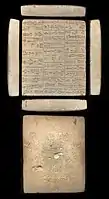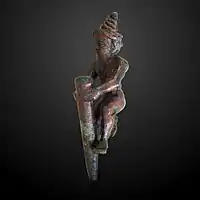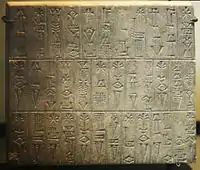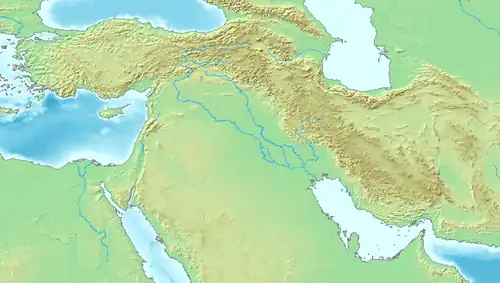| Ur-Baba Sumerian: 𒌨𒀭𒁀𒌑 | |
|---|---|
| Ruler of Lagash | |
 | |
| Reign | c. 2100 BC |
| Predecessor | Kaku or Kakug |
| Successor | Gudea |
| Dynasty | Ruler of Lagash |
Ur-Baba or Ur-Bau (Sumerian: 𒌨𒀭𒁀𒌑 ur-Dba.ba6 or ur-Dba.U2, servant of the goddess Bau) was ensi of Lagash from 2093 BC – 2080 BC (short chronology) or 2157 BC – 2144 BC (middle chronology), roughly contemporaneous with the last king of Akkad, Shu-turul.[3] In one of his inscriptions, he refers to himself as a child of the god Ninagal (Sumerian: 𒀭𒎏𒀉𒃲).[4]
According to inscriptions of Ur-Baba, during his reign Lagash enjoyed prosperity and independence from the Akkadians. His daughter Ninalla married Gudea, who succeeded him as ensi.[3]

%252C_king_of_Lagash.jpg.webp) Cone with name and title of Ur-Baba, king of Lagash
Cone with name and title of Ur-Baba, king of Lagash Ur-Bau foundation tablet. Walters Art Museum
Ur-Bau foundation tablet. Walters Art Museum.jpg.webp) Ur-Bau foundation tablet (front detail). Walters Art Museum
Ur-Bau foundation tablet (front detail). Walters Art Museum Foundation figurine of Ur-Baba
Foundation figurine of Ur-Baba Cuneiform dedication cone of Ur-Bau
Cuneiform dedication cone of Ur-Bau
References
- ↑ "Site officiel du musée du Louvre". cartelfr.louvre.fr.
- ↑ Eppihimer, Melissa (2019). Exemplars of Kingship: Art, Tradition, and the Legacy of the Akkadians. Oxford University Press. p. 108. ISBN 978-0-19-090302-2.
- 1 2 Leick, Gwendolyn (2002). Who's Who in the Ancient Near East. Routledge. p. 185. ISBN 9781134787951.
- 1 2 3 Full translation of the tablet: Edzard, Sibylle; Edzard, Dietz Otto (1997). Gudea and His Dynasty. University of Toronto Press. p. 20. ISBN 978-0-8020-4187-6.
This article is issued from Wikipedia. The text is licensed under Creative Commons - Attribution - Sharealike. Additional terms may apply for the media files.

